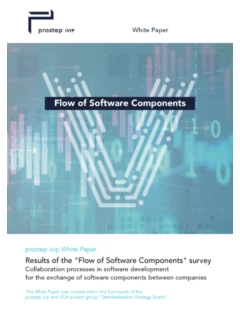White Paper - SSB- Results of the "Flow of Software Components" survey
Format: PDF (18 Seiten)
Sprache: EN
Erscheinungsdatum:
5.
2022
 Preview
Preview
Download
Projektgruppe: SSB
Abstract
The requirements relating to how software components are to be handled in collaborative development scenarios are currently often defined individually by companies in the automotive industry. There are no standardized cross-enterprise processes for the development and deployment of software components at carmakers and companies in the supplier industry. Against the backdrop of increasing technical and legal complexity in the development of safety-related software, the prostep ivip Association has conducted a survey to determine how carmakers and their tier 1/tier 2 suppliers currently handle the development and management of software components and what the current state of the art looks like at the participating companies. The survey, entitled Flow of Software Components (FoSC), was organized and conducted by the Standardization Strategy Board (SSB). The Standardization Strategy Board is a joint project group set up by prostep ivip and the VDA to address issues relating to the need for standardization in the context of crossenterprise collaboration in product development and manufacturing.
The survey and its results will be used to develop a common understanding of the constraints and shared expectations regarding technical and legal issues between OEMs and tier 1/tier 2 suppliers. It is also intended that the survey results provide a basis for providing assistance for the future design of cross-enterprise software development in projects.
The survey prepared and conducted by the Standardization Strategy Board comprised a total of 26 questions. Some questions were closed-ended with a predefined list of response options, while others provided not only specific predefined response options but also the option of a non-specific response ("Other"), which allowed participants to respond in their own words. The original responses are not provided in their entirety here; a summary of the content is provided instead. Some questions allowed the selection of multiple response options. In this case, the sum of all the responses may be greater than the number of survey participants. Questions that allowed multiple responses are indicated in the caption by ("multiple choice"). As some survey participants may not have answered all of the questions using the predefined response options, the number of responses may be smaller than the number of survey participants. The total number of responses to a question is indicated on the right-hand side of the bar charts/diagrams. Questions with predefined responses are displayed as ungrouped, unstacked and non-standardized horizontal bar charts.
The question of OEMs' expectations regarding supplier response times in the event of software errors with different severity levels from the OEMs' perspective and the same question from the suppliers' perspective represents a special case. The results of these two questions are displayed together in a matrix and each individual response is represented by a blue or green dot (see Figure 8).
The survey involved the participation of 28 people from 19 companies, which can be divided into two groups. 17 respondents (61%) stated that they were employed by a supplier, while 11 respondents (39%) stated that they worked for an OEM. Figure 1 shows this distribution in a bar chart.
This white paper first of all examines the importance of software as a component for automotive products and the resulting challenges this poses in the context of software development and software component management in the automotive industry. The survey and its key results are then presented.

